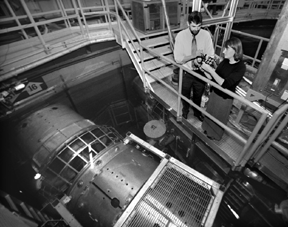Sandia researchers Chris Deeney (1644), Christine Coverdale (15344), and Victor Harper-Slaboszewicz (15344) pushed the Z machine to new limits last month when they used the world’s most powerful X-ray source to test effects of radiation on materials in experiments designed to mimic the response that would occur near a nuclear explosion.

During their experiments, the Z machine generated more than 100 kJ of X-rays (kJ stands for kilojoules, a measure of radiated energy) at 4.8 keV (keV for kilo-electron-volt, a unit used to measure the color spectrum of X-rays). This amount of radiated energy adds significant capability for doing weapons effects experiments; other sources at this X-ray energy have produced only 10 kJ.
“We are excited that we’ve reached this milestone,” Chris says. “The loss of underground tests limited testing capabilities, but this is the closest to the ‘real thing’ we’ve ever achieved with Z-pinches.”
Chris, Christine, and Victor, working with Mark Hedemann, Bill Barrett, and Brett Bedeaux (all of 15344), have been using the Z machine and other sources to determine how materials — in this case candidate materials for a neutron generator — respond when exposed to high levels of radiation. When a nuclear weapon detonates, it produces high levels of radiation, which can cause failure in both nearby and distant systems. To prevent failure, weapon components and subsystems designed and built by Sandia must be certified at radiation levels determined by mission need. Testing materials at high radiation doses and dose rates, coupled with advanced computer calculations, is a major step in selecting materials for weapon components.
Information compiled from the Z machine experiments will be used to validate computer modeling. Chris says computer models are being relied on more and more for certification of components through the Accelerated Strategic Computing Initiative (ASCI) Program because appropriate testing environments are not always available.
“If our findings are close to the computer modeling of the same event, it means the modeling is on track, giving us more confidence in what the model is telling us for regimes that we can’t test,” Chris says.
Since 1992, when full-scale nuclear testing in the United States was halted, scientists have been developing new ways to verify weapons’ reliability without actually detonating them. Working at aboveground simulators like Sandia’s Saturn and Z, scientists have developed X-ray sources that can be used for testing materials and parts. The powerful Z machine, in particular, has allowed for tests in a more realistic physics regime than was previously possible.
These recent experiments were a collaborative effort, not just within Sandia, but within the nuclear weapons community, Chris says. The X-ray source development experiments on Z were sponsored by Ralph Schneider at the Defense Threat Reduction Agency (DTRA) in order to enhance unique testing capabilities within the nuclear weapons community, especially for DoD areas of interest. Victor Harper-Slaboszewicz and Bill Barrett have taken advantage of this source development to collect data for Sandia’s component development and certification programs.
The Z machine is a pulsed power accelerator consisting of capacitors that, like large batteries, are charged with electricity for more than a minute. The electricity is released in 100 billionths of a second, resulting in a 50-trillion-watt, 18-million-amp pulse. This pulse converges on an array of wires, called the load, creating a plasma. This plasma collapses down onto the axis in what is known as a “Z-pinch” and radiates X-rays.
Christine says that another milestone reached in this most recent testing with the Z machine is that the researchers used a “nested” wire technique for the wire load. This technique was developed theoretically by Melissa Douglas (1644) and others at the Naval Research Laboratory and in France.
In previous experiments using titanium wire arrays, the researchers always tested with a single titanium wire array of up to 160 wires. This time they nestled a second array of 48 to 70 titanium wires within the first array of 96 to 140 wires, providing more stability as the wires imploded onto the axis. This added stability improves the quality of the Z-pinch and enhances the utility of the emitted radiation.
Nested wire arrays have been successfully used before on Z, but only with wires made of tungsten. Those experiments produced hundreds of terawatts of X-rays to support the inertial confinement fusion program. Chris and Christine used titanium in their radiation testing experiments because they provide a higher-power and higher-energy X-ray source.
As part of these tests, candidate materials for neutron generators were placed at various distances from the source, usually one-and-a-half to four feet. Using diagnostics to determine how much stress was produced at each distance, and by examining the materials after the X-ray burst, the researchers can see the effects of the radiation.
“We are specifically looking for damage in the materials, checking to see if the radiation causes damage, and the type of damage. For example, we want to know if the material flakes, cracks, or breaks apart,” Christine says. “Testing on the Z machine provides us with a valuable tool in figuring out what materials will survive high radiation exposures.”